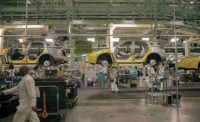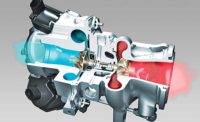Over the past 120 years, the automotive industry has experienced several transformative paradigm shifts that have dramatically changed the process of mass-producing cars and light trucks.
First, there was the moving assembly line in the 1910s. Next, there was the advent of welding and painting robots in the 1970s. More recently, the 1990s witnessed the emergence of just-in-time supply chains and lean manufacturing.
The next big shift will be an environmentally friendly movement dubbed the “circular auto factory.” According to some experts, the circular cars initiative will reshape the auto industry during the next two decades, as OEMs and suppliers attempt to achieve net-zero carbon emissions across the entire vehicle life cycle.
The term “circular car” refers to a theoretical vehicle that has efficiently maximized its use of aluminum, carbon-fiber composites, glass, fabric, rubber, steel, thermoplastics and other materials. Ideally, it would produce zero material waste and zero pollution during manufacture, utilization and disposal.
One of the key elements of a circular car factory is a closed-loop recycling program where disassembly lines are housed in the same facility as traditional final assembly lines. All vehicle components and materials are remanufactured, reused and recycled at the end of life.
The circular car initiative is being driven by growing concern over global warming, in addition to the multibillion dollar race to develop electric vehicles and the need to find a quick, cost-effective way to recycle lithium-ion batteries.
According to the World Economic Forum (WEF), which is driving the circular car movement along with Accenture and McKinsey & Co., the global auto industry annually produces more greenhouse gas emissions than the entire European Union. Approximately 20 percent of these emissions are directly attributable to manufacturing.
The WEF envisions a near-future scenario where 50 percent of materials used in vehicles are in a closed loop and 70 percent are designed for reassembly applications.
“The concept behind the circular cars initiative was first proposed by the WEF in 2020,” says Maya Ben Dror, Ph.D., urban mobility lead for the future mobility platform at the WEF Centre for the Fourth Industrial Revolution. “It is a platform for a multi-stakeholder partnership that is building a community of industry leaders, researchers and governments that see eye to eye. Activity is still primarily focused in Europe, but we are growing globally.
“One of the goals of the circular cars initiative is to bring market leaders together and help the dialogue progress,” explains Ben Dror. “If companies state where they want to be in the future, the market will follow.
“No automotive firm should view circularity as a competitive edge or a PR trick,” warns Ben Dror. “The industry needs to move together in tandem. Hopefully, policymakers will also do their part by enacting the necessary regulations. However, there’s still a long road ahead.”
While the shift toward EVs will decrease use-phase emissions substantially, in the short term it will also increase manufacturing emissions. This is due to the large carbon footprint of batteries. By 2040, McKinsey experts estimate that roughly 60 percent of total automotive life cycle emissions will be directly attributable to materials, with just 40 percent coming from other sources, including logistics, end of life disposal and utilization.
“Due to energy-intensive battery production, EVs generate up to twice as much material emissions as traditional internal combustion engine vehicles,” says Ben Dror. “As we transition to zero-emission vehicles, we will see a shift in supply chains and new assembly line processes.
“Today, roughly half the cost of producing a new vehicle comes from manufactured materials,” claims Ben Dror. “At end of life, little of this value is recoverable due to noncircular design practices and the lack of circularity-focused business models.
“Just as vehicles consume nonrenewable fuel, producing atmospheric pollution and greenhouse gas emissions as atmospheric waste, they also consume vast quantities of currently nonrenewable materials that result in massive quantities of liquid and solid waste,” Ben Dror points out. “These are generally landfilled, processed or down-cycled at end of life.”
“Mobility demand, in terms of both passenger miles and predicted vehicle stock, is expected to increase 70 percent globally by 2030,” adds Axel Schmidt, senior managing director at Accenture who leads its automotive group. “The industry can prepare for this demand, while also decarbonizing to contribute to limiting global warming to less than 1.5 C, by achieving circularity through the lens of energy, water, waste, materials, vehicle lifetime and use.
“Circular cars will be a key building block to serve the growing mobility demand, while at the same time reducing resource consumption and carbon emissions to a level that is truly sustainable,” claims Schmidt. “While many vehicle manufacturers have already set net-zero goals toward carbon neutrality, the roadmap for automotive circularity must be a core element of this transformation and ambition.”
Schmidt believes the adoption of circular economic practices, combined with accelerated electrification efforts, has the potential to reduce carbon emissions by up to 75 percent and noncircular resource consumption by up to 80 percent per mile by 2030.
According to WEF’s Ben Dror, it’s also important to consider factors such as upstream and downstream material usage. “Careful auditing will play a key role in circular car factories,” she points out. “Automakers and suppliers must make a continuous effort to source materials from companies that can ensure they are as circular as can be. As companies become more accountable for their carbon footprints, circularity will bring economic benefits to all participants.
“Attempts have already been made to recycle plastic and metal from batteries, electronics, tires, wheels and other components, but the economies of scale are not there yet,” notes Ben Dror. “Regulation will play a key role in increasing demand for auto parts recycling.
“The process of extracting materials at the end life of a vehicle and then returning it into the manufacturing cycle is a beautiful concept,” adds Ben Dror. “It’s just like what happens in nature, where nothing goes to waste. Everything produced in nature always goes back into the life cycle. That’s what we eventually want to achieve in the automotive world.”
Renault Readies a ‘Re-Factory’
Two European auto assembly plants have already jumped to the forefront of the circular production trend: a Renault factory in northern France and a Volvo Cars factory in southern Sweden.
Renault recently announced plans to convert its oldest assembly plant in Flins, a northwest suburb of Paris, into a new facility focused entirely on the circular economy.
By 2024, Renault plans to stop making new cars at the 70-year-old plant. It will turn the facility into a research, recycling and repair center that it plans to rebrand as the Re-Factory.
“The Re-Factory will enable [us] to respond to the challenges facing mobility and automotive industry players today, and even more so tomorrow,” says Luca de Meo, CEO of Groupe Renault. “This plant, with an objective of a negative CO2 balance by 2030, is fully in line with the [our] global strategy by combining circular economy, reduction of emissions, development of skills, and the creation of new value-generating activities.
“Re-Factory will be structured around four activity centers whose expertise will support the vehicle’s entire life cycle by acting on the main components of the circular economy: supply, eco-design, economy of functionality, maintenance, reuse, remanufacturing and recycling,” explains de Meo.
“The circular economy model implemented in Flins will be based on a set of complementary and convergent loops, aimed at encouraging the use of a vehicle instead of its ownership, extending its life through maintenance, and reusing it or reusing its components for other uses, when other solutions are no longer possible,” says de Meo.
“These four entities will operate in an interconnected and complementary manner,” explains de Meo. “For example, the Re-Trofit center will be able to send used parts to the Re-Cycle center and obtain renovated or reused parts in return. The Re-Cycle center will also supply the other [entities] with parts and materials and will source used batteries from the Re-Energy center to prepare them for new use in second life.
“In addition to this activity, the conversion plan for the Flins site provides for the installation of a [disassembly line] to capture additional volumes and increase [our] capacity to source parts and materials in short loops,” says de Meo. “With an objective of 10,000 vehicles per year on average, this pole aims to be one of the main [disassembly] sites in France and to develop expertise in the deconstruction of electric vehicles.”
Specifically, the new facility will focus on four interconnected functions:
- Re-Trofit. This division will group together all the activities enabling the life of vehicles and their uses to be extended, in coordination with the Re-Cycle division to ensure efficient management of the flow of used parts and materials within the same site. It will also rely on a test and prototyping center for the durability of vehicles and materials, to enrich the design of future vehicles and propose improvements during use.
- Re-Energy. This cluster plans to develop the potential of applications arising from EV batteries and new energies to an industrial scale (including the optimization of the first life of batteries, development of second life applications, such as stationary energy storage, management of the end of life of batteries, and development of technical and supply solutions for new energies such as hydrogen).
- Re-Cycle. This division will consist of all activities contributing to efficient management of resources and their flows to promote the supply of parts and materials in short loops and integrate a growing share of recycled or reused materials.
- Re-Start. To enhance and develop industrial know-how, but also to accelerate research and innovation in the circular economy, this cluster will house an incubator, as well as a training center.
Volvo Focuses on ‘Climate Neutrality’
Volvo Cars’ 57-year-old Torslanda factory recently achieved climate-neutral status. It shares the distinction with the automaker’s engine plant in Skövde, Sweden, which became climate neutral in 2018.
Volvo claims a factory is “fully climate neutral” when it registers no net increase in the emission of greenhouse gases to the atmosphere as a result of the electricity and heating used by the plant.
The flagship Torslanda assembly plant has been powered by climate-neutral electricity since 2008. It now also has climate-neutral heating. Half of the plant’s heating comes from biogas, while the other half is predominantly sourced from district heating through industrial waste heat.
“Establishing Torslanda as our first climate-neutral car plant is a significant milestone,” says Javier Varela, head of industrial operations and quality at Volvo Cars. “We are committed to having a climate-neutral manufacturing network by 2025, and this achievement is a sign of our determination as we consistently work to reduce our impact on the environment.”
Apart from becoming climate neutral, the Torslanda factory also constantly reduces the amount of energy it uses. Targeted improvements in its operations during 2020 resulted in annualized energy savings of almost 7,000 megawatt-hours (MWh), equal to the annual energy usage of more than 450 Swedish family homes.
In the coming years, Volvo plans to make further efficiency upgrades to the plant’s lighting and heating systems, among other things, which should result in additional annual energy savings of around 20,000 MWh by 2023. These energy savings are part of a wider ambition for Volvo to reduce energy usage per car produced in its manufacturing network by 30 percent in 2025. The automaker also plans to develop its own renewable electricity generation capacity on-site.
“[The] climate-neutral manufacturing target is part of [our] climate plan, one of the most ambitious in the automotive industry,” claims Varela. “The centerpiece of the plan is [our] ambition to electrify [our] entire line-up.”
According to Varela, the strategic plan goes beyond addressing tailpipe emissions through all-out electrification. It also seeks to tackle carbon emissions in the company’s wider operations, its supply chain, and through recycling and reuse of materials by embracing the circular economy.













